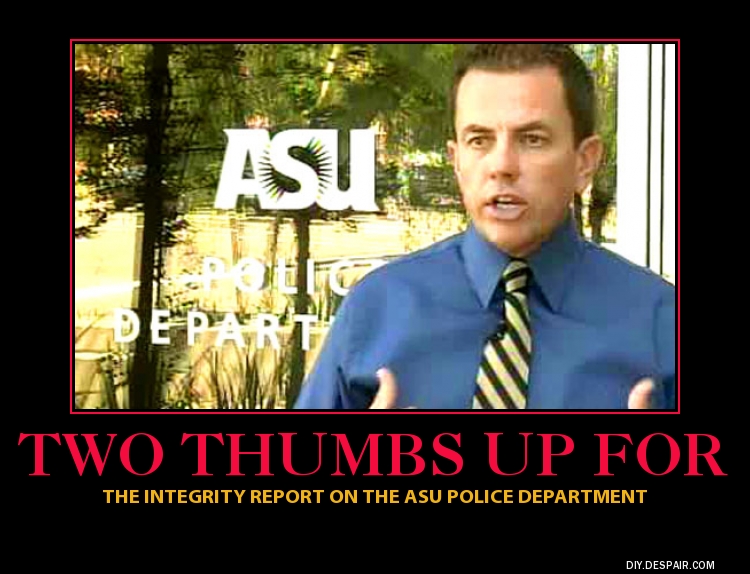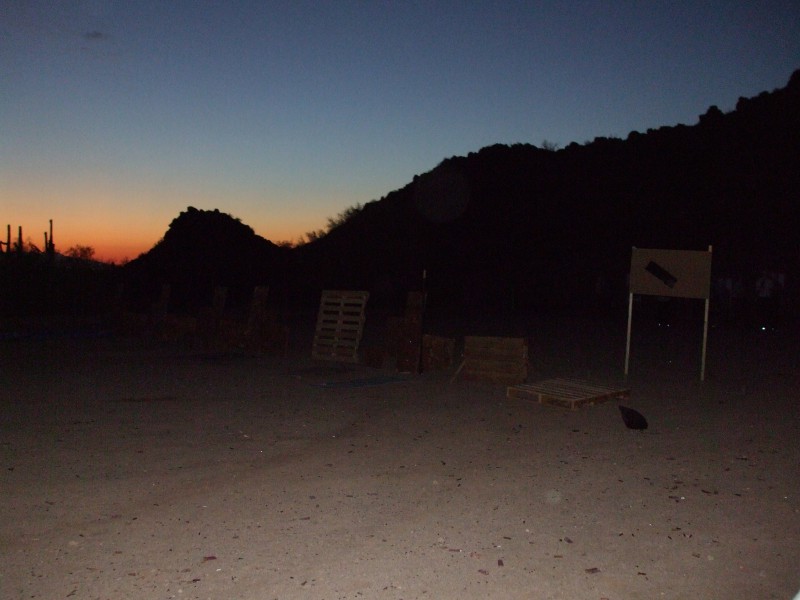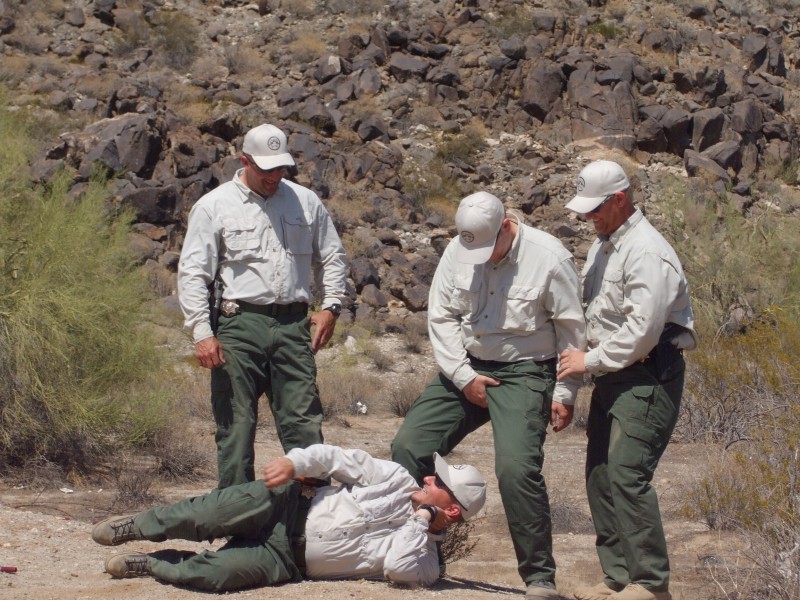Earlier today, the head of ASU’s Human Resources department (Mr. Kevin Salcido) sent this email to all of ASUPD’s employees in regard to a recent photograph posted on The Integrity Report:
To: All Members of the ASU Police Department
Recently , a law enforcement photograph of an ASU police officer, her name, her rank and a picture of her automobile (including her license plate number) was posted to the “Integrity Blog”. This action violates the expectation that was communicated on February 19, 2014 (see below).
A.R.S. §§ 39-123, 39-124, and 39-128 prohibit the release of peace officer photos in all but a limited number of circumstances. The law was passed by the Legislature to help protect and safeguard our peace officers and their families. The recent unauthorized posting of our ASU PD officer’s law enforcement photo on the blog is contrary to law and will not go unaddressed. Again, as noted below, anyone we identify who publicly shares or takes and posts sensitive operational information, obtained through any means , which could potentially compromise the security and safety of the ASU community can and will be subject to disciplinary action up to and including termination.
The large majority of Police Department professionals are devoted to the safety and security of the ASU community and their work is appreciated on a daily basis. There are multiple avenues available for raising concerns including the PD chain of command, the Office of Human Resources and the Office of Equity and Inclusion. This is a university after all and we should be able to have an open exchange of ideas. As the Chief Human Resources Officer, I am disappointed that a very small minority of employees continue to avoid these channels and have become disruptive to our mission of serving and protecting students. Those who are so unhappy here are invited to take their careers elsewhere. They will most assuredly be happier and we will not feel their loss.
Thanks in advance for your cooperation. As always, you can reach me at 5-6608 with questions or comments.
Kevin Salcido
Associate Vice President/Chief Human Resource Officer
Arizona State University
We would like to take a moment to address some of these “expectations” we failed to adhere to, as well as some points brought up in the body of this email.
The “expectations” Salcido mentions refers to an email he sent to all PD employees on February, 2014. In his email, Salcido stated that posting an old schedule to illustrate how low officer staffing levels were “exceeds the bounds of free expression and protected activity because it has safety and security implications for the ASU community”. The “safety and security implications” are only the ones the university itself created by failing to properly staff and manage a police department, period. Beyond that, old schedules are NOT listed as an exemption to the Freedom of Information Act (FOIA), so any member of the public could request the same information we posted.
The assertion that we broke the law by posting a professionally taken photograph of an officer is ludicrous, and the sections of the Arizona Revised Statutes you cite we violated do not appear to be applicable to this situation.
ARS 39-123:
A. Nothing in this chapter requires disclosure from a personnel file by a law enforcement agency or employing state or local governmental entity of the home address or home telephone number of eligible persons.
B. The agency or governmental entity may release the information in subsection A of this section only if either:
1. The person consents in writing to the release.
2. The custodian of records of the agency or governmental entity determines that release of the information does not create a reasonable risk of physical injury to the person or the person’s immediate family or damage to the property of the person or the person’s immediate family.
C. A law enforcement agency may release a photograph of a peace officer if either:
1. The peace officer has been arrested or has been formally charged by complaint, information or indictment for a misdemeanor or a felony offense.
2. The photograph is requested by a representative of a newspaper for a specific newsworthy event unless:
(a) The peace officer is serving in an undercover capacity or is scheduled to be serving in an undercover capacity within sixty days.
(b) The release of the photograph is not in the best interest of this state after taking into consideration the privacy, confidentiality and safety of the peace officer.
(c) An order pursuant to section 28-454 is in effect.
D. This section does not prohibit the use of a peace officer’s photograph that is either:
1. Used by a law enforcement agency to assist a person who has a complaint against an officer to identify the officer.
2. Obtained from a source other than the law enforcement agency.
E. This section does not apply to a certified peace officer or code enforcement officer who is no longer employed as a peace officer or code enforcement officer by a state or local government entity.
This entire statute refers to the actions of an AGENCY, or LOCAL/STATE municipality, NOT the actions of an individual. Furthermore, the picture we published WAS NOT and WILL NOT be serving in the capacity of an undercover officer, nor was her privacy, confidentiality, or safety compromised. Sgt. Pam Osborne has several social media sites accessible to the public in which contain pictures of herself and her family (the pictures were already removed from one site after we published the initial picture), and her picture is available using the “Google” search engine, so her privacy, confidentiality, and safety were apparently not compromised by those arguably more personal pictures. The picture we released was a department sanctioned photograph which was available on the W drive to all PD employees.
Photographs of this nature are regularly used on the ASU website, which is accessible by the public.
The burden of proof is on the State to prove the release of the photograph is a privacy, confidentiality, or safety concern.
The picture of the motor vehicle we also released was taken on a public street in a public place, so we are also legally allowed to publish it. Out of professional courtesy, we did redact the license plate number.
It is ironic how Salcido addresses the issue with this photograph immediately, yet other photographs we have released which show members of the department, dressed in uniform and acting inappropriately goes on unmentioned.
ARS 39-124:
Releasing information identifying an eligible person; violations; classification; definitions
A. Any person who is employed by a state or local government entity and who, in violation of section 39-123, knowingly releases the home address or home telephone number of an eligible person with the intent to hinder an investigation, cause physical injury to an eligible person or the eligible person’s immediate family or cause damage to the property of an eligible person or the eligible person’s immediate family is guilty of a class 6 felony.
B. Any person who is employed by a state or local government entity and who, in violation of section 39-123, knowingly releases a photograph of a peace officer with the intent to hinder an investigation, cause physical injury to a peace officer or the peace officer’s immediate family or cause damage to the property of a peace officer or the peace officer’s immediate family is guilty of a class 6 felony.
This is pretty simple: we did not release the photograph to hinder an investigation, cause physical injury to the officer/her family, or cause damage to the property of the officer/her family. First, there is no investigation to hinder in regard to Sgt. Osborne. Second, we would never want another officer—regardless of how deplorable of a person they are—to be injured or their property damaged. There is no text accompanying the photograph that would incite a reasonable person to commit physical injury or property damage to the officer or her family. Finally, there is no personal identifying information (address, phone number) in the photograph that would compromise the officer’s safety, period.
ARS 39-128:
Disciplinary records of public officers and employees; disclosure; exceptions
A. A public body shall maintain all records that are reasonably necessary or appropriate to maintain an accurate knowledge of disciplinary actions, including the employee responses to all disciplinary actions, involving public officers or employees of the public body. The records shall be open to inspection and copying pursuant to this article, unless inspection or disclosure of the records or information in the records is contrary to law.
B. This section does not:
1. Require disclosure of the home address, home telephone number or photograph of any person who is protected pursuant to sections 39-123 and 39-124.
2. Limit the duty of a public body or officer to make public records open to inspection and copying pursuant to this article.
What is the point of including this statute? This just says the state isn’t require to disclose a photograph if requested through a public records request.
Salcido is correct in stating that “the large majority of Police Department professionals are devoted to the safety and security of the ASU community”, however the qualifying statement of “…and their work is appreciated on a daily basis” is untrue. Who appreciates employees below the Sergeant level? Certainly not the university, who has elected to give all its officers less than a 10 cent pay raise and no cost of living increase (and also giving no pay increase to any civilian employee).
Line-level employees are also not appreciated by the members of their Command staff, who refer to them as “bees”, unleash frivolous IAs if they try to leave ASU, or are told they should work at McDonalds if they don’t like the hostile work environment.
Mr. Salcido himself has shown that he does not appreciate the work of employees at ASUPD nor care about their well-being because he has routinely failed to act upon the concerns of the 10-12+ employees who have brought serious issues to him. Salcido has flatly refused to investigate any of the alleged misconduct reported to him, instead delegating it to the very department that mishandled the issues in the first place.
It is insulting that Salcido suggest we use the PD or HR Chain of Command to address any concerns or problems, because several of us have tried to resolve issues this way with no success. There are several paper trails and digital voice recordings to back up these assertions. There is absolutely no ability to deal with these issues within any Chain of Command at ASU, because the university’s prurient interest in controlling negative press about itself ultimately prevails.
If there is such a small minority of employees causing issues, and—according to you, Mr. Salcido, these issues have no merit—then why has ASU repeatedly addressed The Integrity Report in meetings and memos? If what is being said here is limited to only a handful of employees, why acknowledge the blog and give it life?
The truth is that ASU’s dirty laundry is being aired for the world to see, and for the first time ever, ASU cannot control the negative publicity. We know ASU was accused of stifling the 1st Amendment Rights of a student who spoke against the rising cost of tuition, and we also know that ASU contacted indeed.com and had the site administrators stop people from posting negative comments about ASUPD. It is not a far stretch to assume that ASU would also want to stifle what is being said about its police department online.
However, the primary difference in the case of The Integrity Report (and what makes it such a sensitive issue among Command staff) is that it has the potential to cause many people to lose their jobs, from officers all the way up to President Michael Crow. Everyone who knew some of the issues detailed on this site yet refused to intervene is at risk of being implicated. All these issues coupled with the fact that the public and media are starting to circle like buzzards on a rotting carcass, and you have a perfectly legitimate reason for wanting to stifle The Integrity Report.
When that day comes where people are finally removed from their positions, in Salcido’s own words, “we will not feel their loss”.






